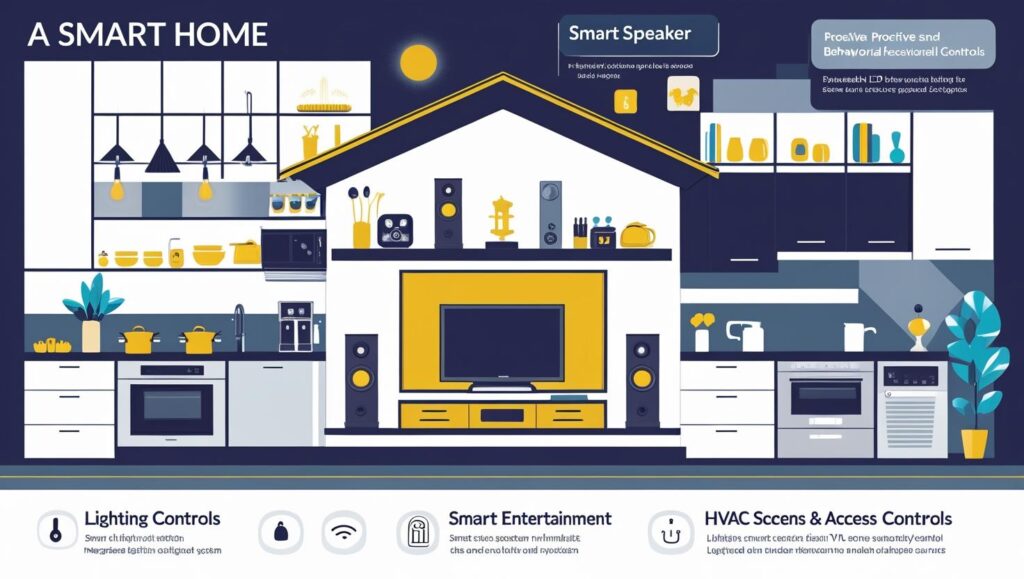The rise of AI in smart home technology is transforming the way we live, offering unprecedented convenience, enhanced security, and efficient energy management. As households embrace digital transformation, AI-powered systems are increasingly integrated into home automation systems, creating seamless, intelligent environments that adapt to our needs.
Revolutionizing Home Automation Systems with AI
Traditional home automation systems have evolved beyond basic remote controls to sophisticated AI-driven platforms that anticipate user preferences and automate routine tasks. These smart systems harness machine learning algorithms and data analytics to provide personalized experiences. From scheduling lighting to adjusting heating, AI enables homes to operate more intuitively, reducing manual intervention.
Intelligent Smart Lighting Solutions
One of the most popular applications of AI in smart homes is in smart lighting solutions. AI-powered lighting adjusts brightness, color temperature, and timing based on occupant behavior and environmental conditions. Whether it’s dimming lights as you settle in for the evening or simulating sunrise to gently wake you up, AI enhances comfort while saving energy.
Enhancing Security with Voice-Controlled Home Devices and Smart Security Systems
AI also plays a crucial role in smart security systems and voice-controlled home devices. Voice assistants like Alexa, Google Assistant, and Siri allow homeowners to control locks, cameras, and alarms with simple commands. More advanced AI security cameras use facial recognition, motion detection, and anomaly detection to alert users of unusual activity, offering peace of mind whether you’re home or away.
Download PDF Brochure @ https://www.marketsandmarkets.com/pdfdownloadNew.asp?id=121

Optimizing Climate with Smart Thermostats and HVAC Controls
Managing indoor climate efficiently is another area where AI shines. Smart thermostats and HVAC controls learn residents’ schedules and preferences, automatically adjusting temperature settings to optimize comfort and reduce energy consumption. Integration with weather forecasts and occupancy sensors further fine-tunes climate control, contributing to energy-efficient smart homes.
Smart Home Industry By Product
Lighting Controls: AI-driven lighting adjusts brightness and color for energy savings and comfort.
Smart Speakers: Voice assistants control multiple devices and provide hands-free convenience.
Entertainment: Smart TVs and speakers offer personalized, voice-controlled media experiences.
Smart Kitchen: Connected appliances enable remote monitoring and automated cooking tasks.
HVAC Controls: Smart thermostats learn preferences to optimize indoor climate and energy use.
Security & Access Controls: AI-powered cameras and smart locks provide enhanced security and remote access.
The Role of Connected Home Appliances and Integration Platforms
Beyond lighting and climate, connected home appliances—from refrigerators and ovens to washing machines and vacuum cleaners—are becoming smarter through AI. These devices communicate with smart home integration platforms, allowing centralized control and automation. For example, a smart oven might adjust cooking times based on ingredient freshness tracked by your refrigerator, all coordinated through a unified system.
Wireless Home Control Systems and Remote Home Management
Wireless technology forms the backbone of modern smart homes. Wireless home control systems enable effortless communication between devices without cumbersome wiring. Combined with AI, they empower users with remote home management, where appliances, security, and lighting can be monitored and controlled from anywhere via mobile apps.
IoT-Enabled Devices and Smart Home Monitoring Systems
AI-driven smart homes rely heavily on IoT-enabled home devices that continuously collect and share data. These connected sensors and gadgets feed information to smart home monitoring systems, which analyze patterns to improve safety, comfort, and efficiency. Whether it’s detecting a water leak or notifying about a forgotten door, AI helps prevent problems before they escalate.
Market Trends and Future Outlook for AI in Smart Homes
The global smart home industry was valued at USD 84.5 billion in 2024 and is projected to reach USD 116.4 billion by 2029; it is expected to register a CAGR of 6.6% during the forecast period. The smart home market trends indicate rapid growth, driven by consumer demand for convenience, security, and energy savings. As AI technology matures, expect deeper integration, enhanced interoperability, and more intuitive user interfaces. Innovations such as predictive maintenance, emotion-sensing environments, and AI-driven health monitoring are on the horizon.
Additionally, the focus on home connectivity solutions is expanding, enabling more devices to work together harmoniously within the smart ecosystem.
AI is at the heart of redefining convenience and control in smart homes. From smart lighting solutions to advanced smart security systems, AI empowers homeowners to create environments that are safer, more comfortable, and energy-efficient. With continuous advancements in AI in smart home technology, the future promises homes that not only respond but anticipate our needs, truly transforming everyday living.
Know More Semiconductor and Electronics Market Research Reports & Consulting Reports @ https://www.marketsandmarkets.com/semiconductorand-electonics-market-research-87.html
FAQ – AI in Smart Home Technology: Investor Insights
Q1: Why is AI in smart home technology a promising investment opportunity?
AI-driven smart home technology is experiencing rapid adoption due to increasing consumer demand for convenience, security, and energy efficiency, creating substantial growth potential in a multi-billion-dollar market.
Q2: What market trends are driving growth in AI-powered smart home solutions?
Key trends include rising integration of IoT-enabled devices, expansion of voice-controlled home devices, advancements in AI algorithms for personalization, and growing focus on energy-efficient smart homes.
Q3: Which product segments show the highest growth potential?
Segments such as smart lighting controls, smart security systems, HVAC controls, and connected home appliances are witnessing significant innovation and consumer uptake, representing attractive areas for investment.
Q4: How important is interoperability and integration in this market?
Interoperability via smart home integration platforms is crucial, as consumers prefer ecosystems where devices from different brands seamlessly work together, enhancing user experience and driving higher adoption rates.